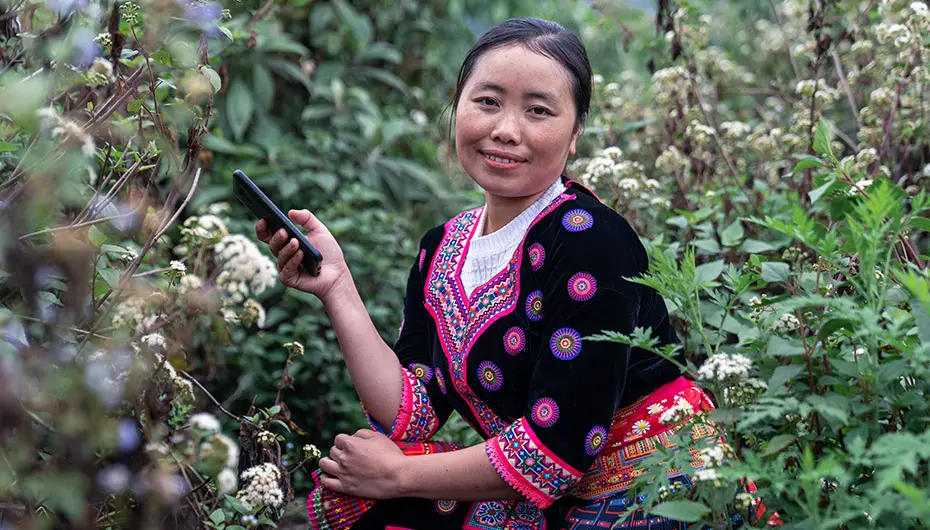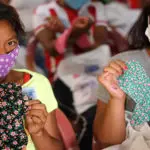Media Centre - Media release - 25 May 2021
Time to Act: Digital solutions key to ending child marriage in Asia

Everyday life has been forced to shift online during the COVID-19 pandemic, and as a result child, early and forced marriage customs have begun to operate in an increasingly digital world. But, as a new report from Plan International shows, the solutions to tackling child marriage may also be found online.
(25 MAY 2021): Digital tech could be the key to ending child marriage by 2030, according to new research conducted by Plan International in the Asia-Pacific region.
“Time to act: Let’s Go Digital: Ending Child, Early and Forced Marriage through Digital Technology” analyses how more than 40 existing digital technologies and apps have the potential to prevent and end child marriage.
Since the start of the pandemic, different online platforms and mobile applications have been used to raise awareness of imminent risks and threats. The online space is becoming one of the main channels of reporting suspected cases of early and forced marriage to law enforcement agencies and strengthening referral pathways.
Governments around the world have committed to eliminating child marriage by 2030, as part of the UN’s Sustainable Development Goals.
Yet currently, 12 million girls are still being married off before the age of 18 each year. And the COVID-19 pandemic has only made things worse, with an additional 13 million girls potentially being put at risk of child, early or forced marriage (CEFM).
Susanna Legena, CEO of Plan International Australia, said: “Every girl deserves the right to choose who, when – and if – she wants to marry. But around the globe, child marriage denies girls the freedom to make their own decisions, be in charge of their bodies, and to have choices and opportunities for their futures.”
However, as this groundbreaking research from Plan International reveals, digital technologies can help to eliminate child marriage.“When large social media companies like Facebook, YouTube and Instagram get behind campaigns to end child marriage, we have a real chance of eliminating this devastating practice once and for all.”
Bhagyashri Dengle, Plan International Asia-Pacific Hub Regional Director, said: “Child marriage has been holding girls back for too long, depriving them of their rights, limiting their life opportunities, often reducing their existence to slave-like conditions of submission, exploitation and exclusion.
“With the current pandemic and all its domino effects on regional economies, healthcare systems, and girls’ education – to name but a few – child marriage is raising its menacing head again, threatening to reverse decades of progress made in curbing its vicious advance.
“Our research shows that we have a clear window of opportunity to harness the power of digital tools.”
The time to act is now: it is time to respond to this ancient harmful practice by reaching for modern means, including state-of-the-art digital technologies and online solutions.The report, which is based on an in-depth literature review and interviews with Plan International staff, youth and other INGOs, provides vital recommendations for using online solutions to eradicate CEFM.
The organisation heard from girls themselves, who highlighted the importance and immediacy of digital solutions to tackle child marriage issues arising online.
Huong*, a 21-year old member of Plan International Vietnam’s Youth Advisory Committee, said: “In my village, many boys and girls made friends online and fell in love virtually. Then they met each other outside, got pregnant, and then dropped out of school at age 14 or 15. It’s become very common now. I think we should do something to prevent this issue, such as promotion messages on child marriage elimination on social media platforms.”
The research found that digital technologies had the following benefits in fighting child marriage:
- Anonymity, which is especially important for accessing information about taboo subjects such as sexual and reproductive health.
- Creating networks with the ability to interact and share information instantly.
- Access to information and the creation of communities without the requirement of physically being in the same space.
- Safe online spaces can be a lifeline for survivors of gender-based violence, oppressed and threatened minorities and can be indispensable in times of emergencies and disasters.
- Girls, young women and youth can access safe and confidential guidance on sexual reproductive health and rights as well as access support services.
- Online content can provide information and resources on how young people can reduce their exposure to child marriage and reduce their risks.
A major focus of Plan International’s work on ending CEFM involves engaging with girls and young women, developing and strengthening their skills so that they are empowered to make decisions about their own lives and futures.
Lopika*, from Nepal, was just 16 when her parents told her they had found a boy who would be good for her to marry.
If I had been married so young, it would have been like a suicide,- she said.
“I might get pregnant and giving birth wouldn’t be easy. It’s a risk for my physical health and wouldn’t be good for my mental health either. I would have to obey my in-laws and my fate would depend on them. I would feel like my life is dark and lonely.”
Instead, Lopika spoke with facilitators at Plan International Nepal’s Children’s Club, who were able to put her in touch with local partners FOHRE, which helped her to persuade her parents to prevent the marriage just before it was due to take place
Plan International is calling for development actors, technology organisations, donors and governments to ensure a gender lens is applied to every step of the process of designing and applying new technologies and online solutions.
The organisation also recommends strengthening partnerships between development actors and private sector players and technological giants to create new technologies to further accelerate efforts in ending child marriage.
Ms Dengle added: “Our mapping of digital technologies is designed to inspire others to innovate, and to consider a selection of digital solutions.
“Plan International, and other development organisations working in this space must create a long-term, sustainable strategy when developing new technologies or integrating existing technologies into programmes designed to eradicate child marriage.
This is vital, because the challenge of CEFM is complex, and the root causes are multiple.“But we strongly believe that digital solutions can improve educational outcomes, empower youth economically, protect young people from violence and improve sexual and reproductive health. All of these things will help us achieve our goal of eliminating child marriage by 2030.”
The full report can be accessed here.
NOTES TO EDITORS:
- Access to digital technologies remains a challenge, especially for girls and young women living in rural areas and due to digital gender divide. This relates both to digital infrastructure and device ownership.
- It is critical to understand and mitigate digital disparities, because they can exacerbate existing gender inequalities which can impact girls’ opportunities to contribute to the labour force, obtain new skills and access information and services. This is especially the case during the COVID-19 pandemic, as life has shifted increasingly online.
For further comment please contact Plan International Australia media and ambassador manager James Norman on 0451291775 or public relations advisor Claire Knox on 0452326549
About Plan International Australia
Put simply, we’re the charity for girls’ equality. We tackle the root causes of poverty, support communities through crises, campaign for gender equality, and help governments do what’s right for children and particularly for girls. We believe a better world is possible. An equal world; a world where all children can live happy and healthy lives, and where girls can take their rightful place as equals.
Media contacts


